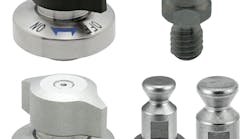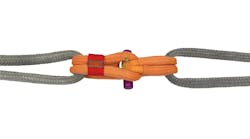Metrology Fixtures for CMMs, Equator Gaging Systems, Vision and Multi-Sensor Machines
Oct. 17, 2015
Related To: Renishaw Inc.
Fixturing plates have a hard-anodized coating of Nituff to resist wear and scratching. Steel components are black oxide coated for improved durability, and magnetic standoffs are made with alnico magnets for temperature stability and wear resistance. To facilitate fast, reproducible setups and ISO/QS documentation, each fixture plate has an alphanumeric grid pattern etched in, and each fixturing component has its own easily visible and identifiable part number. Most fixturing components are hand tightened and require no special tooling. Sold in preconfigured kits, the fixturing system for vision applications supports a variety of inspection tasks, regardless of part size, shape and material. A comprehensive range of micro components is available for very small parts, and clamps with soft tips are recommended for delicate workpieces. New features for vision and multi-sensor machine applications, such as Quick Load Corners (QLCs) and Interchangeable Vision Fixtures (IVFs), further enhance the system functionality. QLCs offer unique functionality for quick part turnaround, making quick and easy viewing and inspection possible. Each has built-in magnets so that Renishaw’s acrylic plates can snap into a precise, repeatable position and can be loaded/unloaded quickly and easily. Steel pins are pressed into the sides of the acrylic plates to correspond with the magnets in the QLC. The edges of the QLC are serrated so that parts can be mounted and fixed directly against them using Renishaw M4 and M6 fixturing components for rapid, easy inspection. QLCs are specifically designed for use with all vision and multi-sensor machines. IVFs are custom-designed to enable fast and repeatable plate loading for larger vision and multi-sensor machines. Multiple plate set-ups are possible on a single machine bed to improve inspection process throughput and efficiency. Renishaw fixtures for CMM and Equator gages are also sold in preconfigured kits typically consisting of one base plate and a comprehensive selection of components, ranging from basic to advanced configurations. All kits include a component tray for organizing and storing the parts. Additional components can be purchased to increase the system’s flexibility. Modular fixturing has significant advantages over improvised methods, such as blue-tack or double-sided tape. Modularity eliminates the need to redesign and manufacture fixtures every time a new piece part is added to an existing inspection process. It also allows new inspection programs to be modeled and new fixture assemblies designed ahead of the manufacture of the first piece part.





